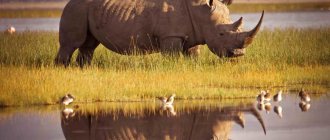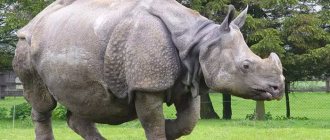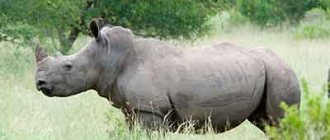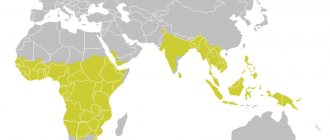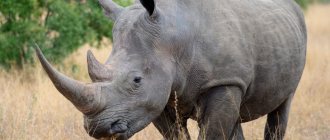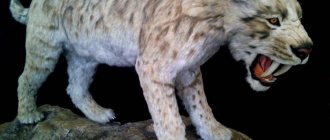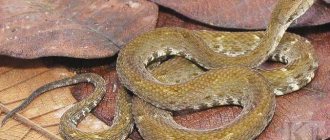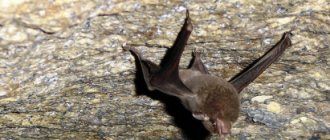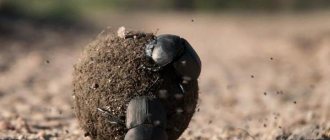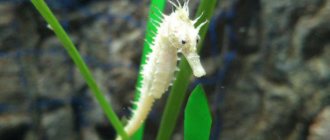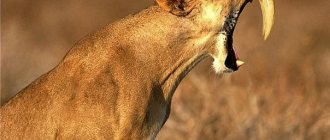The woolly rhinoceros is an extinct animal of the order of odd-toed ungulates of the rhinoceros family.
Lived during the last glaciation, approximately 140 thousand years ago, over a vast territory covering Europe and Asia. During its life on Earth, this species was a typical representative of the mammoth fauna and traveled near the glacier, where the air temperature was very comfortable.
If we compare the habitats of the woolly rhinoceros with modern territories, then Davos in Switzerland, the foothills of the Tien Shan in Asia and Teberda in the Caucasus will be similar in climate. We can say that this large mammal lived in resort conditions.
Woolly rhinoceros (Coelodonta antiquitatis).
What, after all, were the living conditions during the time of the spread of animals such as the woolly rhinoceros across the planet? To maintain the glacial mass in normal condition, high pressure and clean air are necessary. Consequently, there was an anticyclone over the habitats of ancient rhinoceroses. The sky was clear, the sun was shining and coolness spread over the lush greenery. Since at that distant time there was practically no wind, the animals did not suffer from the cold.
The glacier, under the influence of the sun's heat, gradually melted and fed the surrounding vegetation with fresh water. Glacial water accumulated and formed rivers and lakes. Woolly rhinoceroses spent their lives in such beautiful conditions for 130 thousand years.
Representatives of this species were similar to rhinoceroses living on earth today, but had a more elongated body. On the back of the animal’s neck there was a kind of hump made of powerful muscles. The fat reserve that was deposited in the hump could save the rhinoceros in a hungry year. The animal was covered in reddish-brown fur, and its limbs were three-toed and short. Beneath the surface of the long coat was a thick, warm undercoat, and a mane of coarse hair adorned the withers. The animal's tail was 50 cm long.
The woolly rhinoceros became extinct about 9 thousand years ago.
Description and features of the woolly rhinoceros
The woolly rhinoceros is an extinct member of the equid order. He is the last mammal from the rhinoceros family to be found on the Eurasian continent.
According to many years of work by the world's leading paleontologists, the woolly rhinoceros was not inferior in size to its modern counterpart. Large specimens reached 2 m at the withers and a length of up to 4 m. This giant moved on thick, stocky legs with three toes, the weight of the rhinoceros reached 3.5 tons.
Compared to an ordinary rhinoceros, the body of its extinct relative was quite elongated and had a muscular hump on the back with a large supply of fat. This fat layer was consumed by the animal’s body in case of starvation and did not allow the rhinoceros to die.
The hump on the back of the neck also served to support its massive, laterally flattened horn, which sometimes reached 130 cm in length. The small horn, located above the large one, was not so impressive - up to 50 cm. Both females and males of the prehistoric rhinoceros were horned.
For many years, the woolly rhinoceros horns could not be properly classified. The indigenous peoples of Siberia, in particular the Yukaghirs, considered them to be the claws of giant birds, about which there are many legends. Northern hunters used parts of horns in the manufacture of their bows, this increased their strength and elasticity.
Woolly rhinoceros in the museum
There were many misconceptions about the skull of the woolly rhinoceros . At the end of the Middle Ages, in the suburbs of Klagenfurt (the territory of modern Austria), local residents found a skull that they mistook for a dragon. For a long time it was carefully kept in the city hall.
The remains, discovered near the town of Quedlinburg in Germany, were generally considered to be fragments of the skeleton of a fairy-tale unicorn. Looking at a photo of a woolly rhinoceros , or more precisely at its skull, it really can be mistaken for a fantastic creature from myths and legends. It is not for nothing that the white woolly rhinoceros is a character in a popular computer game, where he is credited with unprecedented abilities.
The jaw structure of the Ice Age rhinoceros is very interesting: it had neither fangs nor incisors. The large teeth of the woolly rhinoceros were hollow inside, they were covered with a layer of enamel that was much thicker than on the teeth of its modern relatives. Thanks to the large chewing surface, these teeth easily ground both hard, dry grass and thick branches.
The photo shows the teeth of a woolly rhinoceros
The mummified bodies of woolly rhinoceros, perfectly preserved in permafrost conditions, make it possible to restore its appearance in sufficient detail.
Since the era of its existence on Earth fell during the glaciation period, it is not surprising that the thick skin of the ancient rhinoceros was covered with long, thick hair. In color and texture, its coat was very similar to that of European bison; the predominant colors were brown and fawn.
The hair on the back of the neck was especially long and shaggy, and the tip of the half-meter long rhinoceros tail was decorated with a brush of coarse hair. Experts believe that the woolly rhinoceros did not graze in herds, but preferred to lead an isolated lifestyle.
The photo shows the remains of a woolly rhinoceros
Once every 3-4 years, a female and a male rhinoceros briefly created a pair for the purpose of procreation. The female's pregnancy lasted about 18 months; as a rule, one cub was born, which did not leave the mother until the age of two.
When studying the animal's teeth for wear and tear and comparing them with the teeth of our rhinoceroses, it was found that the average lifespan of this powerful herbivore was about 40-45 years.
Where did Elasmotherium live?
Photo: Caucasian Elasmotherium
There were several species of Elasmotherium that lived in different parts of the world.
This is how evidence of their existence was found:
- in the Urals;
- in Spain;
- in France (Rouffignac Cave, where there is a clear drawing of a giant rhinoceros with a horn from its forehead);
- in Western Europe;
- in Eastern Siberia;
- in China;
- in Iran.
It is generally accepted that the first Elasmotherium lived in the Caucasus - the most ancient remains of rhinoceroses were found there in the Azov steppes. The Caucasian Elasmotherium species was the most successful because it survived several Ice Ages.
On the Taman Peninsula, the remains of Elasmotherium were excavated for three years, and according to paleontologists, these remains are about a million years old. Elasmotherium bones were first found in 1808 in Siberia. Traces of fur around the skeleton were clearly visible in the rockwork, as well as a long horn growing from the forehead. This species was named Siberian Elasmotherium.
The complete skeleton of Elasmotherium was modeled after the remains found in the Stavropol Paleontological Museum. It is an individual of the largest species that lived in the south of Siberia, Moldova and Ukraine.
Elasmotherium settled both in forests and in flat areas. Presumably he loved wetlands or flowing rivers, where he spent a lot of time. Unlike modern rhinoceroses, he lived quietly in dense forests, as he was not afraid of predators.
Now you know where the ancient Elasmotheriums lived. Let's find out what they ate.
Woolly Rhino Habitat
Woolly rhinoceros bones are found in abundance in Russia, Mongolia, Northern China and a number of European countries. The Russian North can rightly be called the homeland of rhinoceroses, because most of the remains were found there. From this we can judge its habitat.
The tundra-steppe was home to representatives of the “mammoth” fauna, including the woolly rhinoceros. These animals preferred to stay close to bodies of water, where vegetation was more abundant than in the open spaces of forest-steppes.
fragment_zuba_nosoroga_merka_2.jpg
Fragment of a tooth from a Merck rhinoceros.
Photo courtesy of the Land of the Leopard National Park “Every year, scientists make new discoveries in the unique territory of the Land of the Leopard - from finds of animals of the ancient Pleistocene fauna to the water deer recorded for the first time in Russia,” comments Yuri Darman, Candidate of Biological Sciences, Deputy Director of the Federal State Budgetary Institution “ Land of the Leopard" in science, Honored Ecologist of Russia. — Epochs change, the climate changes, and the task of nature reserves is to record all this in the “Chronicle of Nature.”
Woolly rhinoceros nutrition
With its menacing appearance and impressive size, the woolly rhinoceros was a typical vegetarian. In summer, the diet of this odd-toed ungulate consisted of grass and young shoots of bushes; during the cold winter, it consisted of tree bark, willow, birch and alder branches.
With the onset of an inevitable cold snap, when snow covered the already sparse vegetation, the rhinoceros had to dig out food with the help of its horn. Nature took care of the herbivorous hero - over time, mutations occurred in his appearance: due to regular contact and friction with the crust, the nasal septum of the animal became ossified during his lifetime.
mp_tiunov.jpg
Mikhail Tiunov at work.
Photo courtesy of the Land of the Leopard National Park In addition to the remains of the Merk rhinoceros, during excavations in the Sukhoi cave, scientists discovered a lot of bones of other animals. Among them are prehistoric hyenas, bears, badgers, hares, wolves, mice, foxes and many other animals, the species of which remains to be determined through laboratory research, so experts are confident that there are still many discoveries ahead.
We did a special project about another unique cave - Crimean Taurida. What is this unique natural monument? And why it gives scientists hope to uncover the secrets of the settlement of ancient people - read here.
Why did woolly rhinoceroses become extinct?
The end of the Pleistocene, a comfortable life for rhinoceroses, became fatal for many representatives of the Animal Kingdom. Inevitable warming forced the glaciers to retreat further and further north, leaving the plains under the rule of impassable snow.
Under the deep snow cover, it became increasingly difficult to find food, and skirmishes occurred among the woolly rhinoceroses for grazing on more profitable pastures. In such battles, animals wounded each other, often the wounds were fatal.
With the change in climate, the surrounding landscape also changed: in place of flooded meadows and endless steppes, impenetrable forests grew up, absolutely unsuitable for the life of a rhinoceros. The reduction in food supply led to a decrease in their numbers; primitive hunters completed the job.
There is reliable information that woolly rhinoceroses were hunted not only for meat and skins, but also for ritual purposes. Even then, humanity showed itself not at its best, killing animals only for the sake of horns, which were considered cult among many cave peoples and allegedly had miraculous properties.
The lifestyle of a solitary animal, low birth rate (1-2 cubs every few years), reduction of territories suitable for normal existence and the unfortunate anthropogenic factor have reduced the population of woolly rhinoceroses to a minimum.
The last woolly rhinoceros became extinct approximately 9-14 thousand years ago, having lost an obviously unequal battle with Mother Nature, like many others before and after it.
peshchera_suhaya.jpg
Sukhaya Cave.
Photo courtesy of the Land of the Leopard National Park Excavations in the Sukhoi Cave in the Land of the Leopard were carried out within the framework of a scientific cooperation agreement between the Land of the Leopard Federal State Budgetary Institution and the Federal Scientific Center for Biodiversity of the Far Eastern Branch of the Russian Academy of Sciences in the fall of 2022 under the leadership of Doctor of Biological Sciences Mikhail Tiunov. Judging by the numerous finds of ancient bones, hyenas lived in this cave tens of thousands of years ago. It was thanks to them that Sukhaya turned out to be a real treasure trove for paleontologists. Predators brought meat and bones of killed animals into their “home,” among which were Merk’s rhinoceroses.
Age of Mammoths
In the Upper Pleistocene in Northern Eurasia, a complex of mammal fauna developed, called the mammoth fauna, or mammoth complex. It is the mammoth that is one of the main elements of this animal community, which also included musk oxen, woolly rhinoceroses, bison, reindeer, saigas, arctic foxes, wolves, etc.
The fauna of large mammals, which lived 70-10 thousand in Siberia, was very diverse. The mammoth was its main component, since the bones of these elephants are found in almost all locations in Siberia. Because of this, it received the name “mammoth fauna” of the late Pleistocene (the Pleistocene is a geological period that began 1.85 million years ago and ended 10 thousand years ago). In addition to the mammoth, it includes 19 more species (some of them are listed below in order of frequency of occurrence in Siberia): ancient horse (2 or 3 species), ancient bison, reindeer, giant deer, red deer, saiga antelope, woolly rhinoceros, elk, cave bear, cave lion. Some of these animals have become extinct, but most of them still live in Eurasia, but not at all where they used to be, in other climatic zones, and these species no longer form communities together as before. Reindeer live in the tundra and taiga, and the horse is found (it used to be found, there are no wild horses left now) in the steppe and forest-steppe zones. This change in animal ranges clearly shows us what enormous changes have occurred in the world over the past thousands of years.
